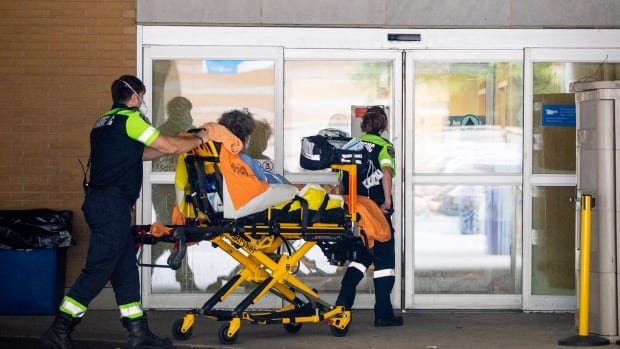ERs face worse wait-times this summer, as 'waiting-room' medicine gets creative
A person is brought into the emergency room of Toronto General Hospital on August 4, 2022, after they issued an alert about staffing shortages in their critical care unit. (Carlos Osorio/CBC)White Coat Black Art26:30Emergency rooms in crisisStaying in the ER for hours or even days waiting for a hospital bed should be seen by Canadians as unacceptable, says an emergency physician.But Dr. Catherine Varner, who is also deputy editor of the Canadian Medical Association Journal, recently wrote an editorial warning that emergency departments across the country face record-setting wait times and closures this summer. "There have been times over the last two years where I'm standing in our waiting room with many patients waiting to be seen, many of whom are uncomfortable and sick, where you want to sort of shout at the rooftops and say, 'This is what a health-care system in collapse looks like,'" Varner said in an interview with colleague Dr. Brian Goldman, host of CBC Radio's White Coat, Bla



Staying in the ER for hours or even days waiting for a hospital bed should be seen by Canadians as unacceptable, says an emergency physician.
But Dr. Catherine Varner, who is also deputy editor of the Canadian Medical Association Journal, recently wrote an editorial warning that emergency departments across the country face record-setting wait times and closures this summer.
"There have been times over the last two years where I'm standing in our waiting room with many patients waiting to be seen, many of whom are uncomfortable and sick, where you want to sort of shout at the rooftops and say, 'This is what a health-care system in collapse looks like,'" Varner said in an interview with colleague Dr. Brian Goldman, host of CBC Radio's White Coat, Black Art.
This week, premiers committed to improving health care as a key priority following their meeting in Winnipeg. This comes as ERs across the country still face overcrowding, record wait-times, lack of hospital beds, closures and staff burnout. The situation is critical for some patients, with reports across the country of people dying while waiting in hospitals.
Some studies suggest that patients admitted to hospital who have to stay in the ER because beds on units aren't available may face a higher risk of dying the longer they stay in the emergency department.
Varner, who works at a Toronto ER, said patients start out frustrated. But when people with a fractured hip, for instance, wait hours for hospital admission, they tell her fear sets in, which turns to "profound disappointment."
Trying to maintain a patient's privacy in a waiting room is challenging, she said. This has led to what she says is a new field — waiting-room medicine — where providers adapt to seeing patients sitting on a chair in the waiting room instead of lying on a stretcher or by using unconventional spaces, such as in an ambulance parked on the hospital driveway.
ER doors should never be locked, daughter says
But wait-times aren't the only issue facing Canada's ERs. Shelley Gosselin's father, Charles Marsh, died before he was even able to get into an open emergency department.
Gosselin said Marsh, 78, was otherwise healthy when he had an asthma attack in February. He drove to the local ER in Bonavista, N.L., for oxygen, but it was unexpectedly closed due to staffing shortages. Marsh called an ambulance the next day and died en route to another ER.

Gosselin, who spent 25 years working as a nurse in the military, said it is hard to look at the degrading health-care system from both sides, knowing people are dying because their medical needs go unmet.
"There were nurses in the hospital that could have opened the doors and let him in and given him the oxygen," the Ottawa resident claimed on The Current last week.
"Never, ever should ER doors be locked and turn people who need the basic essentials in life away."
At the time, Eastern Health said in a statement to CBC News it is unable to publicly discuss any specifics regarding an individual patient case due to the Personal Health Information Act.
In March, the province's health minister offered doctors a $200,000 signing bonus to work in Bonavista.
'The safety net'
Dr. Paul Atkinson, deputy editor of the Canadian Journal of Emergency Medicine, said the ER closures in rural areas across the country should not be happening.
But Atkinson, who heads the emergency medicine department for Horizon Health Network in Saint John, N.B., notes there's another issue contributing to ER crowding: people who look to ERs for 24/7 access to unscheduled care.
ERs weren't designed for that, he said; they were designed to deal with emergencies such as cardiac arrests, strokes, and limb-threatening injuries.
"But how do you do that when you are also the safety net, when you're also the admitting area, the holding area, when you're also the primary care area or the area where people come when they've nowhere to sleep on a cold, Canadian evening?" he said.
Both physicians said there is no easy answer to the ER crisis, calling for more resources. These include increasing hospital beds, retaining experienced triage nurses and adding specialists, diagnostic imaging and operating rooms.
For instance, Canada has one of the lowest rates of acute care hospital beds per capita of the OECD nations, at just 2.6 beds per 1,000 people.
Varner suggested expanding the role of nurse practitioners, dietitians and counselors so patients can access comprehensive primary care in a timely manner. That's important given so many family physicians are retiring as the country's population also grows and ages, she said.
Atkinson hopes innovation, such receiving specialist advice virtually for critically ill patients, will also help staff at smaller ERs to cope better.
How paramedics can help
As a paramedic in Nova Scotia for more than 40 years, Kevin McMullin sees how his profession also adjusts to new challenges. McMullin figures he's been called to help resuscitate patients experiencing a cardiac arrest in a hospital "probably at least a half a dozen times in recent years."
In June, a cardiac arrest at Soldiers Memorial Hospital in Middleton, N.S., made headlines when nurses had to summon members of the volunteer Middleton Fire Department to resuscitate a patient who was admitted on one of the floors.

McMullin, the business manager for the union that represents paramedics and patient transport operators in Nova Scotia, said it is now normal for the province's emergency medical centre to dispatch medical first responders from local fire departments, as well as paramedics, to Code Blues for hospitalized patients.
"They mutter and sigh at the system," McMullin said of paramedics responding to patients in cardiac arrest in hospital. "If you're in a rural area, you used to be able to transport to the nearest hospital [that] might only be 15 minutes away. Now your transport may be up to an hour. So, as a result it means that you have patient-care issues for a longer period."
McMullin's proposed solutions to the ER crunch include:
- Hire transport operators for routine calls.
- Have clinical paramedics staff the emergency call centre together with doctors and nurses.
- Allow community paramedics to follow up on patients discharged from hospital.
The Nova Scotia Health Authority said on the night in question, Soldiers Memorial Hospital's inpatient units were fully staffed, including a doctor on-call.
Despite the ER crunch, Varner stressed anyone who needs emergency care should come. As always, patients who need resuscitation will be seen first.
"Please be patient because we will see you, we will provide high quality care, but it may take longer," she said.

What's Your Reaction?















